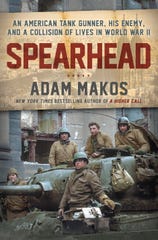‘Spearhead’ is a WWII book on tank strategy, but humanity is central focus

"Spearhead," by Adam Makos (Photo11: Ballantine Books)
If 60 years of B-grade war movies have taught us anything, it’s that tanks are unstoppable lumbering behemoths with frightening firepower that terrorize a battlefield.
But what’s it really like to climb into a tank and take it into war?
In actual combat, tanks are far more vulnerable than viewers of most black-and-white films may realize. In particular, World War II tank crews risked incineration from enemy shells that could turn their vehicles from protective fortresses into burning prisons.
“Spearhead: An American Tank Gunner, His Enemy, and a Collision of Lives in World War II” (★★★★ out of four, Ballantine Books, 416 pp.) is a detailed, gripping account that leaves B-grade images behind. The book, by military writer Adam Makos, is the remarkable story of two tank crewmen, from opposite sides of the conflict, who endure the grisly nature of tank warfare.
Makos, author of “Devotion” and best-selling “A Higher Call,” turns from air combat to the ground advance of Spearhead, the U.S. Army’s legendary 3rd Armored Division. The division is heading to an epic confrontation in Cologne, the “symbolic guardian” of Germany, in the ending months of the war.
A frame from a film sequence shows German tank crew members escaping their burning Panther tank after it was hit by fire from Clarence Smoyer’s Pershing tank in Cologne, Germany. (Photo11: National Archives)
The tanks fought their way through some of the most distinctive battles of the war: Mons, Liege, across the West Wall – the Siegfried Line – the Battle of the Bulge and the invasion of Germany. The story opens in September 1944, three months after the D-Day invasion, and the tide is turning against the Third Reich.
We see that blood-soaked push mainly through the eyes of Clarence Smoyer, a young tank gunner from Pennsylvania with a talent for precise shooting:
“Clarence should have missed. The target was set a thousand yards away and yet he hit it all eight times without breaking a sweat, leaving everyone to question his secret,” Makos writes.
The answer is easy: “The secret to his marksmanship was simple: fear of letting down his crew.”
The crew of Clarence Smoyer’s Pershing tank, left to right: Homer Davis (bow gunner), Bob Earley (commander), William McVey (driver), Clarence Smoyer (gunner), and John DeRiggi (loader). (Photo11: National Archives)
Smoyer is part of an M4A1 Sherman tank crew attached to Easy Company, 32nd Armor Regiment. He and his comrades are moving across France and Belgium into Germany, battling resistance from German forces determined to slow the Allied advance at any cost, even though they realize they’ve already lost the war.
As one German soldier writes in his diary: “The town is in ruins, but we will defend the ruins.”
Smoyer’s Wehrmacht counterpart is Gustav Schaefer, a young tank radioman/bow gunner from Arrenkamp in northern Germany. He and his weary crew are part of Panzer Brigade 106, stationed in Luxembourg City not far from the German border. His inclusion in the story gives a unique view of what the Germans endured. He and Smoyer will meet in Cologne.
By then Smoyer and his crew will have a T26E3 Pershing, a new American “super tank.” The Pershing, with heavier armor and greater firepower, will prove a lethal force against the Germans.
It’s hard not to be fascinated with these multi-ton war vehicles, but Makos wisely avoids focusing solely on the machines. While American and German tanks are given due comparison in terms of size, armament, speed, reliability and quirks, it’s soldiers, civilians and their encounters who rightfully take center stage here.
Most importantly, “Spearhead” takes pains to humanize the comrades of Smoyer and Schaefer. Those killed in battle aren’t just faceless soldiers — they’re people with names and history and family waiting back home. Even though some are encountered only briefly, they all matter, and readers feel a sense of loss with each one.
Smoyer survives but he can’t forget the fighting. In time, he revisits Germany, reuniting with comrades and finding a few surprises along the way.
World War II is retreating from our memory as its veterans pass on. As a compelling story of men at war, “Spearhead: An American Tank Gunner, His Enemy, and a Collision of Lives in World War II” provides some remedy. It shows what Clarence Smoyer and others endured and enjoins us to remember. At the very least, these men are owed that.
Find your next great read:
More new books: 5 books not to miss: ‘The Border,’ ‘Priory of the Orange Tree,’ ‘Say Nothing’ and more
New book: What did William Shakespeare look like?
New review: ‘The Last Romantics’ a moving and utterly engrossing read
Source: Read Full Article


